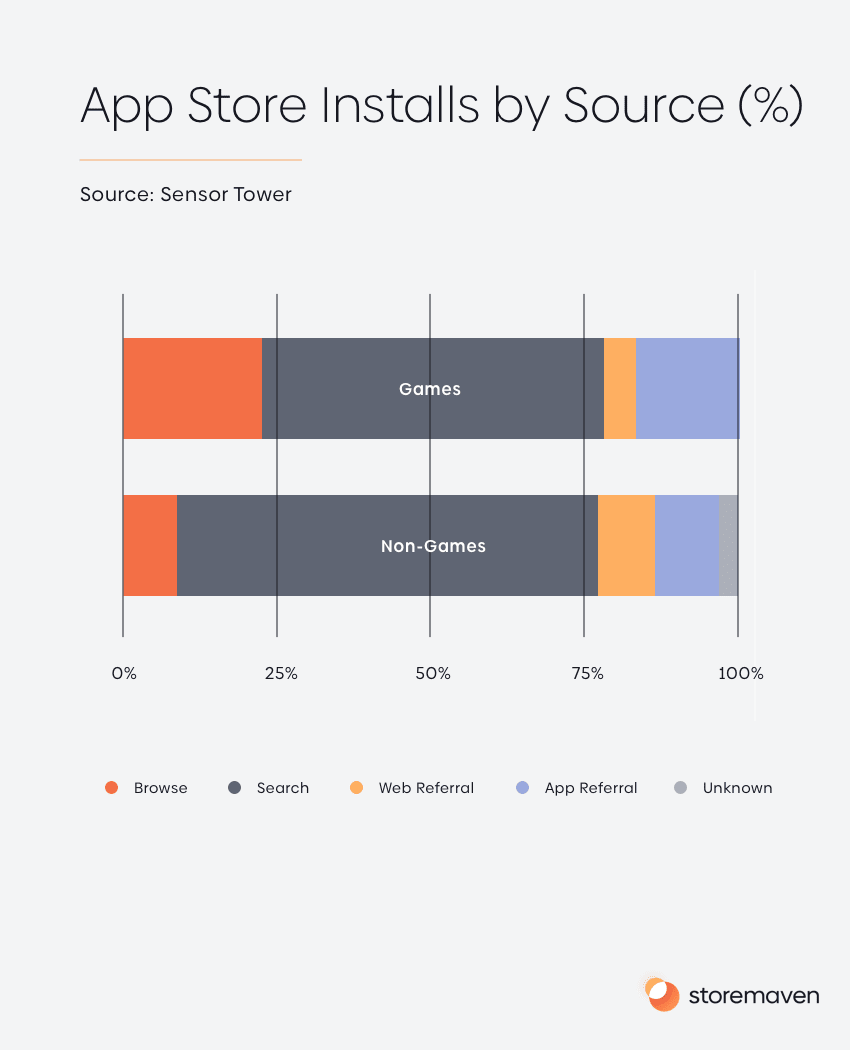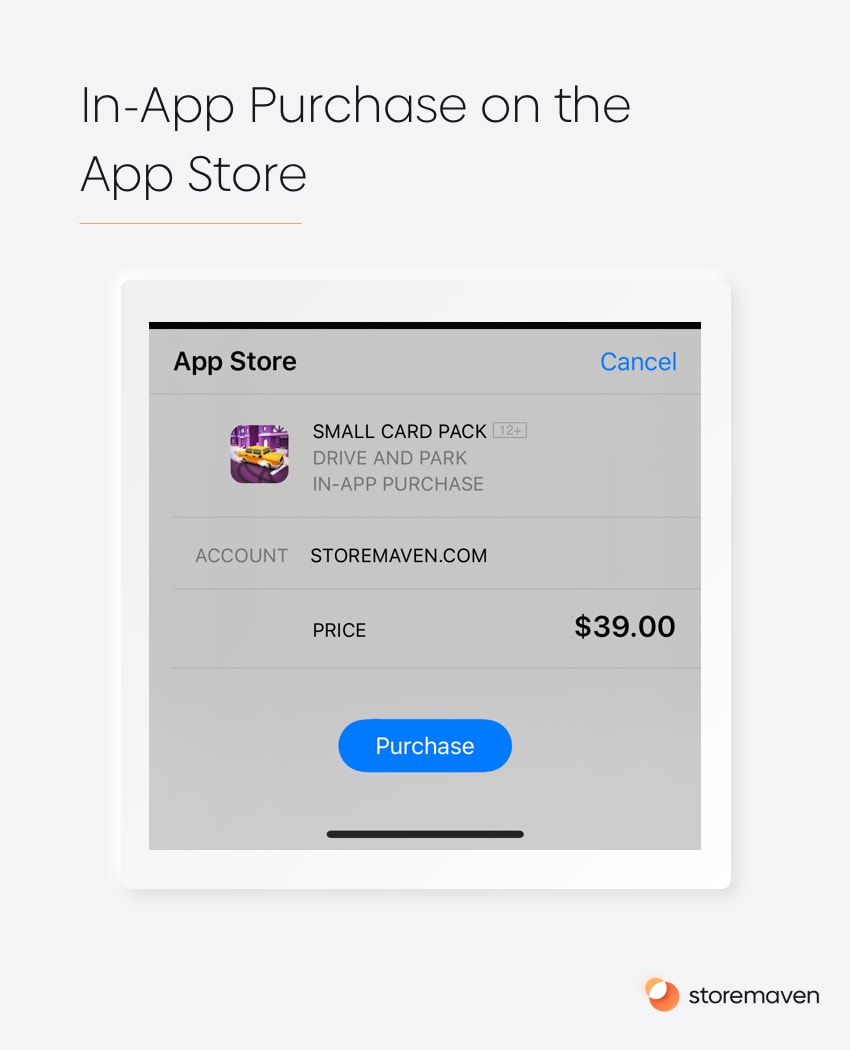Search results and rankings on the App Store and Play Store are grounded in complex and dynamic algorithms. A combination of user search queries and keywords determine search results and rankings, yet the details of both the App Store and Play Store algorithms are shrouded in secrecy. Furthermore, these algorithms regularly evolve to produce more relevant results (and to combat developers who have discovered exploits).
Despite the algorithms’ complexities, ASO experts have identified trends and insights into the mechanisms that drive search results (i.e. what shows up) and app rankings (i.e. in what order results show up). The following article describes the facets of ASO strategy developers can leverage to benefit from these rankings.
App Store Search Algorithms
Favorable search results are fundamental to an app’s success – a 2018 study by Sensor Tower indicated that 56% of game installs and 69% of non-game installs are the direct result of a user query.
On the surface, the role of search appears simple: Match user queries to relevant results. However, “relevancy” is inherently complex. In addition to considering the queries themselves, search algorithms must also account for spelling errors, junk content, “trustworthiness,” popularity, and much more. Thus, it is not sufficient for developers to simply rely on clever keywords to gain visibility from potential users and drive downloads.

Ranking Algorithms
Much like search algorithms, ranking algorithms are quite intricate. Predictably, the App Search algorithms weigh app titles, the developer names, and the app category. However, Google Play and App Store algorithms also include review scores, review volume, the number of downloads, click through rates, usage and discard rates, crashes, update frequency, and more.
It’s important to note that algorithms vary between app marketplaces. Below, we describe the key factors and elements that developers should consider when shaping their ASO strategy.
Apple App Store Ranking Factors
In 2019, Apple was subject to international scrutiny and an antitrust investigation that ultimately divulged details about its App Store algorithms. In short, Apple relies on 42 factors to drive search results and rankings – the most important factors are user behavior, downloads, ratings, and relevance.
Here is a list of top-ranking factors that the Apple App Store takes into account when deciding which apps to surface to users searching for various terms.
App Name: This 30-character field should be used for the most relevant keywords, as these keywords are weighted significantly higher when indexing your app for search results than keywords used elsewhere. However, keep in mind that human users also rely on an app name to determine relevancy, and so it is critical to select comprehensible and clear keywords.
App Subtitle: This field presents an opportunity to further – yet briefly – explain your app to prospective users. Keywords used in the subtitle will also be weighted significantly by Apple’s search algorithm.
Keyword field: This keyword field should be used for relevant terms not included in your title and description, and developers are permitted 100 characters. Prospective users will not see your selected keywords, and thus comprehensibility is not important. Apple also builds a keyword bank from this field, and thus the order is also irrelevant.
In-App Purchases: Apple derives a profit from apps that generate revenue from in-app purchases instead of in-app advertisements. Thus, it is suspected – though not confirmed – that apps offering in-app purchases are ranked favorably. Moreover, in-app purchases themselves can rank for keywords.

Rating and Reviews: Positive reviews – and the keywords they include – suggest user satisfaction, increasing the likelihood that the app is ranked higher by the eager-to-please algorithm. For more on ratings and reviews in the app stores, click here.
Updates: App updates are often positively correlated with user satisfaction, leading to better reviews and, in turn, higher rankings. Frequently updated apps are also more relevant by definition, and thus will rank higher. For more on app store update frequency, click here.
Note that Apple Search Ads uses an entirely different algorithm. Rather than rely on the traditional title, description, and keywords, Apple Search Ads use a bidding system. More detail is available here.
Downloads and Engagement: These metrics, which measure how popular your app is, include install velocity and daily growth, and they are critical to app rankings. Developers can improve downloads and engagement by improving tap through rates, optimizing their App Store creatives and messaging, updating frequently, and more.
It’s important to note that Apple takes into account App Units (first-time installs) when determining download velocity. This is a different metric than install figures that are provided by your Mobile Measurement Partner (MMP), as the platforms can’t see these MMP metrics, they only use their own metric for first-time installs which in Apple’s case is the App Unit metric. According to our research and data, driving high volumes of first-time installs, or App Units is one of the most impactful things you can do to increase ranking.
This can be done by improving your page conversion rate for new users as well as leveraging paid User Acquisition (UA) campaigns that focus on new users as opposed to lapsed users.
Google Play Store Rankings Factors
The Google Play Store ranking factors and search algorithm resembles many ranking factors of the core Google Search – thus, in addition to our ASO resources, knowledge of SEO is valuable to rank in Google Play Store.
To rank on the Google Play Store, there are important elements that should be optimized:
App Name and App Description: These fields are similar to the App Store, although the Play Store’s title may occupy 50 characters and the description length is significantly longer than an App Store subtitle. Also, note that keyword usage is quite different. Google’s crawlers leverage order and repetition to determine keyword importance. The app name is traversed first, followed by the description, and the words that are read first are weighted more heavily. That said, Google’s algorithms are highly sensitive to spam and keyword stuffing, and so it is key to write both the name and description in a manner comprehensible to people.
Backlinks: Backlinks are web links to your App page. The greater the volume of quality backlinks, the higher the ranking in the Google Play store. Thus, by focusing on link building, developers can boost their rankings.
Google Play Store Page Performance: Similar to downloads and engagement, page performance is the result of creative optimization, localization (adapting your app page to various languages and geographic regions), click-through rate, conversions, and more. Similar to the App Store, Google Play will surface apps that get a higher velocity of first time installs.
Android Vitals: If an app crashes or fails to respond more often than the industry standard, users will inevitably be dissatisfied, and so in addition to poor reviews, Google is incentivized to rank the app lower than stable alternatives.
Rating, Reviews, and Updates: Also similar to the Apple App Store, these metrics are all correlated to user satisfaction and relevancy.
Google Tags: Google Tags functions similarly to categories in the App Store. You can pick up to 5 tags for your app from a predefined list. Then Google will use your selected tags to categorize your app. Although this has no direct effect on your Google Play ranking, it certainly does help the algorithm rank your app for the right keywords.
Optimizing the above elements will help you increase your Google Play rating.
Leverage The Search Algorithms to Improve Your Results and Rankings
The strength of your keywords represents the foundation of your ASO strategy. Note that long-tail keywords are generally more successful than popular terms, and be certain that your keywords capture your app features, use cases, competitors, and market. Furthermore, continuously track your keywords and adjust to account for new trends and user interests.
It is also vital to tailor your ASO strategy to the app marketplace. While the Apple App Store explicitly asks for keywords and does not benefit from repetition, the Google Play Store derives keywords from your description. However, in both marketplaces, titles are given more weight than keyword fields and long descriptions.
As we’ve seen, one of the most powerful ways to signal to the platforms’ algorithms that your app is relevant is by driving a high number of first time installs. Consider leveraging UA campaigns that drive a significant volume of first time installs to improve your rankings and visibility.
Lastly, and perhaps most obviously, focus on creating a good app. User satisfaction and engagement heavily influence app rankings, and both metrics can only be improved with diligent attention to app reviews, ratings, conversion rates, updates, and more.

















